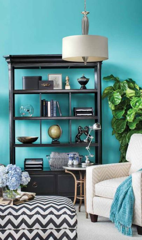Consciously integrating texture into your design scheme can provide the finishing-touch to a room. As you gaze around your space, you’ll see that texture does indeed play a factor in the room’s composition and aesthetic, so it’s a matter of harnessing the textural elements in our environment and placing them into pleasing arrangements to create a desired atmosphere in the space.
1. Use Full-Of-Texture Objects
All objects have a textural identity of rough, smooth, hard, soft, shiny, or plush. Using various décor and accent pieces like mirrors, rugs, lamps, pillows, and furniture, you can pick and choose various textures of your liking.
While décor objects and materials such as leather, glass, and polished surfaces reflect and conduct light clearly along a visual path, other materials such as velvet, suede, and matte surfaces tend to absorb light and make it visually spread.
2. Pick a Texture Palette
When you plan to decorate with texture, remaining consistent with a few distinct textures will help items pair together, but still ‘pop’. Texture, like light, is visually defined by its opposite, and the most successful examples of decorating with texture will be experienced when there is a balance in textural composition. For example, a kitchen with rough plaster walls will be balanced by shiny tiles on the floor, and a combination of shiny and matte-finished pottery and accessories will make the space feel inviting and balanced.
A kitchen with an preponderance of slick, shiny surfaces will read clean and cold, but once a balance of matte surfaces is introduced through ceramics and pottery, soft throw-rugs, and other accessories, the environment will achieve a more balanced and inviting feel.
3. Incorporate Colors
You’ll find that your chosen colors for each room or space will also be part of your texture strategy, and can enhance textures in place when introduced into the composition. Think of how each color complements the overall scheme of a room, and choose colorful objects that align with your texture palette. For example, find a bright, matte lamp, or a metal set of frames. Colors and textures can make a space unique, and tie all of your décor tactics together gracefully.
4. Use Your Lighting
So how does lighting factor into the texture equation? Your lighting scheme will play a critical role in defining the textures of its environment, and tie together textures to create a feeling of comfort and style.
-
Intensity of Light
The intensity of the light will determine how the texture of an object or surface is read by the eye and interpreted into feeling and thus mood. For instance, a strong white light travelling across the rich texture of the plastered walls will create sharp and deep shadows making the wall feel solid and possibly harsh. It will make shiny and reflective surfaces gleam and glare into your visual attention, and much of the soft and cozy ambiance will be lost from your suede and velvets because the bright light will reduce or eliminate contrasts.
-
Quality of Light
The natural daylight that streams through your windows travels through a subtle rainbow of color every day, and one will notice the effect of that changing light on the surfaces within your home or working environment. Light bulbs are offered with varying temperatures of light, from cool to warm, and then of course colored lights are available to set the tone and mood for a particular space.
5. Choose Unique, Stylish Fixtures
The design of light fixtures, their finish, their color, and their shape can all add texture to your space. The lighting fixtures that you select have the ability to introduce texture into your environment through their design and through their performance. Our vast showroom has a multitude of options from the best in the lighting industry.
One vendor that we rely on for quality, textured lights is Quoizel. They have a line has a variety of intriguing fixtures that can be used for illustrating the power of lighting to experience texture in a space.
- Their portable table lamp, Agate features a rustic tree designs with stained glass branches and carnelian stone accents. This lamp introduces a grace of line and texture through its flowing physical design along with the soft, glowing, colored illumination produced by the stained glass shade.
- The Piccolo Pendant has a simple, yet intriguing design that utilizes a heavy-gauge wire and a filament bulb to cast linear patterns across the surfaces of its nearby environment.
- The Crystal Studded Pendant, Catherine, will cast rainbows, shafts of light and shade, and contour lines across nearby surfaces, and is available with a gold or bronze finish.
Learning to decorate with texture will enhance the mood, tone, style, and character of the room. Explore and experiment with the textures of your space, and discover how your lighting choices can make all the difference in your décor.



